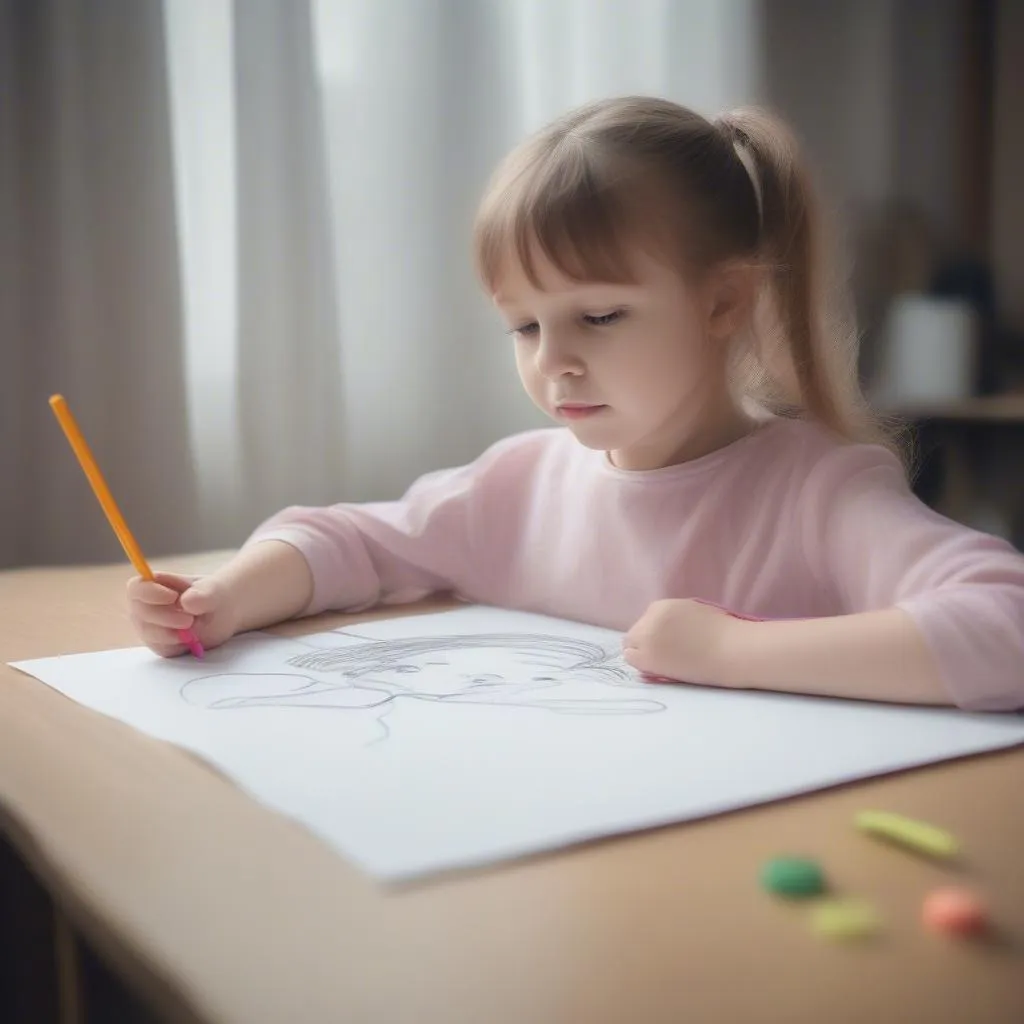“Draw a worm, draw a snake, draw a bird, draw a fish…” – Hearing the familiar lullaby, my heart suddenly swells with childhood memories. Drawing, an activity that seems simple, yet holds a magical world, where bright young sprouts are nurtured and developed. So, what’s special about a preschool drawing program? Let’s explore with “TUỔI THƠ”!
Preschool Drawing: A Journey to Unleash Creative Potential
Preschool drawing programs are a journey of sowing seeds for the future generation, helping children develop comprehensively in physical, intellectual, and emotional aspects. Like the proverb “Master one skill, honor life,” practicing drawing skills from a young age helps children:
Enhance Thinking and Creativity Skills
Drawing is an activity that helps children express themselves, think independently, and come up with unique ideas. Through drawing, children can imagine, create, and turn their ideas into reality.
Develop Fine Motor Skills
Holding a pen and controlling strokes helps children train the dexterity and flexibility of their hands, enhancing hand-eye coordination.
Promote Language and Communication Development
Besides describing what they draw, children also develop communication skills, exchange, and share emotions and thoughts with friends and adults.
Help Children Learn and Absorb Knowledge Effectively
Drawing is not just a recreational activity but also an effective learning method. Children can learn about shapes, colors, sizes, animals, objects… through their drawings.
Preschool Drawing Programs Suitable for Each Age Group
Preschool drawing programs are scientifically designed to suit each age group, psychology, and learning ability of children.
Preschool Stage (3-5 years old):
- Focus on developing pen-holding skills, basic strokes, and simple shapes.
- Teach children how to use colors, coordinate colors, and create colors.
- Encourage children to freely create, express emotions and thoughts through drawings.
Elementary School Stage (6-10 years old):
- Train sketching, perspective, composition, light, and color skills.
- Teach children advanced drawing techniques such as: pencil drawing, watercolor painting, oil painting, landscape painting, still life painting…
- Create opportunities for children to approach diverse drawing styles such as: abstract painting, realistic painting, illustration…
Effective Preschool Drawing Methods
To make preschool drawing programs effective, teachers need to apply methods suitable for each age group, psychology, and learning ability of children.
Direct Practice Method
- Teachers guide children to practice directly, demonstrating drawing skills in a clear and easy-to-understand way.
- Encourage children to freely create and express their personality through drawings.
Game-Based Method
- Using drawing-related games helps children get excited and absorb knowledge naturally and comfortably.
- Examples: coloring games, drawing by theme, finding hidden drawings…
Storytelling and Reading Method
- Teachers tell stories and read books about drawing, art, helping children visualize, feel, and create creative inspiration.
- Examples: telling stories about famous artists, reading books about art forms…
The Role of Teachers in Preschool Drawing Programs
Teachers play an important role in imparting drawing knowledge and skills to children.
Teachers need to:
- Have solid professional knowledge of art, child psychology, and pedagogy…
- Be able to convey knowledge and skills in an easy-to-understand and engaging way.
- Have love, patience, and create a comfortable and fun learning environment for children.
Notes When Teaching Preschool Drawing
To make preschool drawing programs effective, some points should be noted:
Create a Fun, Comfortable, and Safe Learning Environment
- Prepare sufficient drawing tools, colors, and drawing paper… suitable for each age group, ensuring safety for children.
- Create a fun and lively learning space, encouraging children to freely create and express their personality.
Evaluate and Encourage Children Appropriately
- Do not evaluate or compare children with each other, causing pressure on children.
- Give praise, encouragement, and motivate children’s creativity.
Provide Useful Materials and Knowledge for Children
- Teachers can provide children with useful materials and knowledge about art, art history, famous artists…
- Encourage children to learn and explore more about the diverse world of art.
The Story of “Little Rose”
Early childhood education expert Nguyen Thi Mai, author of the book “The Art of Early Childhood Education,” once shared: “I remember the first time I taught drawing to a 4-year-old girl, she was very shy and didn’t dare to hold a pen. I told her a story about a little rose, a rose that wanted to show off its beauty to the world but was hesitant. I guided her to draw the rose, each petal, each leaf, and finally, the little rose bloomed in her painting. At that moment, I saw joy radiating on her face, it was the joy of discovery and creation. Since then, she has become more confident and loves drawing more.”
Advice from “TUỔI THƠ”
Let the “little roses” freely shine and develop their creative potential. Preschool drawing programs are not just a journey to train skills, but also a journey to sow seeds for a future generation full of talent and creativity.
 A young girl is drawing in a preschool art class.
A young girl is drawing in a preschool art class.
Let “TUỔI THƠ” accompany you on the journey of sowing seeds for the future.
Want to know more about preschool drawing programs? Contact “TUỔI THƠ” via phone number: 0372999999, or visit the address: 234 Hao Nam, Hanoi. We have a 24/7 customer care team.
Leave a comment or share this article if you find it helpful!